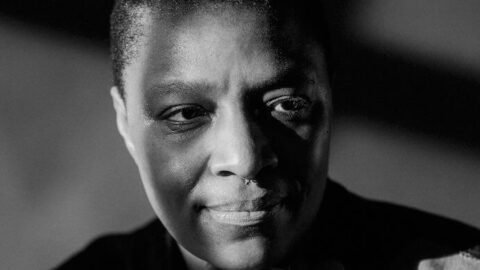As a child, Mazz Swift would introduce themselves as a violinist – even though they had never touched the instrument before. It was a wish that, spoken enough, became real, setting them on a twisty path that speaks to the fact that there is no one road to success, to developing your creative voice.
Mazz’s debut album, The 10000 Things: PRAISE SONGS for the iRiligious (May 24, New Amsterdam Records), is a sonic picture of the goals, ideas, purpose, and priorities of a violinist who has intersected with major institutions and figures in the classical and jazz realms of New York City. Born and raised in the Big Apple, their parents were “musically inclined:” Mom loved classical, and Dad loved jazz. They ensured their children took full advantage of the free classical music events throughout the city. And when Mazz declared themselves a violinist and started lessons at age seven, it became their world.
“I’m autistic and ADHD,” Mazz shared with me on our recent video call. This state of being, which they describe as “neuro-emergent,” led to them hyperfocusing on the violin and quickly excelling, attending LaGuardia High School for the Performing Arts and participating in many orchestral afterschool programs. “I would say that would be my strength, I just loved being in orchestra; and I’m pretty sure I got into Juilliard on the strength of my orchestral audition,” they said.
Mazz entered Juilliard at 16 – way too young to balance the responsibilities that can drive even the most organized and focused of students into the ground. But that was not the only problem. Mazz realized that the training they were receiving at the illustrious institution was incompatible – in fact, detrimental – to their creative interests and aspirations. The skills and creative possibilities in jazz became more and more intriguing, but you can’t study jazz violin at Juilliard.

So Mazz left school. They started joining jam sessions at jazz clubs in the city, but they quickly discovered how hard it was to “break out of classical training” to improvise. “The way that we say ‘this is how we play,’ you have to unlearn those habits and expectations that are so ingrained, and it is physically difficult to do the opposite,” they shared.
It soon became clear it was not simply a matter of unlearning, but undoing; they needed to take a break. “Quitting was the best thing that happened to me,” they said. “I stopped playing for a couple of years, I picked up martial arts…I went traveling, I lived on a farm and learned a whole bunch of stuff, took care of animals, learned how to build things, learned how to garden..I tell people: put your instrument down and go get connected with something that feels real good to you that has nothing to do with music.”
When they did return to the violin, their playing “morphed into a deep meditation practice,” offering them a new perspective on their artistry. “At some point it just clicked that improvisation is a form of meditation, and learning how to meditate is a really great way to learn how to improvise,” they explained.
In the years to come, Mazz became further immersed in the experimental networks and circles that have come to define their own practice. They joined the Burnt Sugar Arkestra, an ensemble that traverses the “experimental soul-jazz-hip hop spectrum,” which was founded by Mazz’s mentor, the late Greg Tate. It was there they met Lawrence Douglas “Butch” Morris, developer of Conduction. Short for “conducted improvisation,” Conduction is a practice of absorbing and directing the musical energy of a group “to create music in the moment that is cohesive,” Mazz explains.
Morris’ Conduction method has led to the development of compositional schools, its most recognized descendant being the composer and multi-instrumentalist Tyshawn Sorey. While Mazz has utilized this practice, they see themselves as a free improviser who centers their experience in classical, jazz, and traditional Irish music. “Conduction feels very different then my own solo/free improvisation practice, because one, I’m playing with a group…but I’ve learned how to freely improvise in that [Conduction] setting, there was structure, but also a lot of freedom.”
They’ve brought this ethos – individual expression in established frameworks – to commissions for Kronos Quartet; projects funded through Jerome Hill Artist and United States Artists Fellowships; their work as a member and teaching artist of the Silkroad Ensemble; and now The 10000 Things. The majority of the tracks are built upon the Negro spirituals transcribed and printed in the 1867 book Slave Songs of the United States, a core text for scholars of African American culture and American music.
Mazz is less concerned with notions of authenticity than their enactment of Sankofa: going back to get what is needed, which for them is a reestablishment and “reclaiming” of their folk music. And so the album becomes a method of connecting with the past on their own terms – an archival call-and-response, a solemn signification on a repertoire that is often treated more as a conduit than malleable creative material.

The 10000 Things is not an album for listeners expecting to hear spirituals and work songs in “traditional” contexts; they appear fragmented and reimagined amidst electronic distortion and brittle violin timbres; they appear in earthy textures and flowing lyricism, like in poet Regie Gibson’s performance on the opening track, “No More My Lord.” In their track description, Mazz sees images of a chain gang, writing “Now that I know ‘freedom’ there’s nowhere to go but forward, but I still hear the ring of the pickaxe, and the overseer’s switch.”
“Don’ I Know-dis?” is a brilliant play on the title and purpose of Dona nobis pacem from the Catholic mass, layered and interwoven with biting pragmatism as Mazz sings and considers, “May there be peace on earth?” This segues immediately to “BLVK Meditation,” a mellow and focused dance track with hopeful exuberance simmering beneath, enhanced by Gibson’s vocals. “New Anthem,” the final track, is built upon African polyrhythms, R&B beats, and unified violinistic ostinatos. Its gorgeous melody is punctuated with electronic chirps. Recitations from Mazz and conversations between them and their Sisters/Siblings: Camille Morrison, Nanette Hill, and Allisyn Swift, drive the emotional core, culminating in a sonic wash that is comforting, clear-eyed, and secure.
Like the intertextuality of the spirituals, where “heaven” could mean as many things as freedom through death or escape to the north, Mazz signifies: creating something new through something familiar, and philosophizing through creativity. It is a beautiful portrait of expression with a purpose: respect for the past without acquiescence, and artistry that blooms when structure does not squash creativity.
I CARE IF YOU LISTEN is an editorially-independent program of the American Composers Forum, and is made possible thanks to generous donor and institutional support. Opinions expressed are solely those of the author and may not represent the views of ICIYL or ACF.
You can support the work of ICIYL with a tax-deductible gift to ACF. For more on ACF, visit the “At ACF” section or composersforum.org.
























